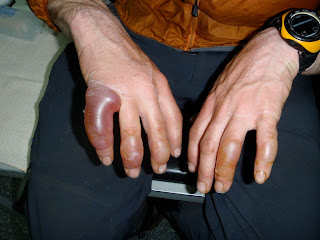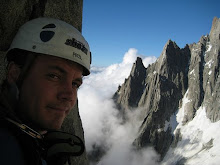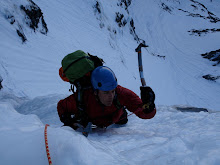More than 140 million people are currently affected by the disaster and more than 2 million are without homes or shelter. Some villages were wiped out completely and don't even make the news or total count as they are too remote. It is hard to even imagine how bad it is amid the devastation. It feels helpless to be at home and not being able to help.
Sure, we venture to the mountains to try to climb to the summit of a mountain, but the experience and the journey becomes more complex than simply getting to the top of something. Let's face it, everything has to be in your favour to succeed on the mountain- the weather, winds, snow conditions, health, acclimatisation and a good team. The word "Insh'allah" which is so commonly used in Pakistan is perhaps the best description of the entire trip and the attitudes of the country and its people.
"Insh'allah"literally means 'God Willing' and reminds me of the Indian head waggle that becomes a response to most questions that are asked. Will the weather be good? Will the planes fly? Any idea where my luggage is ? Are the roads open or blocked by landslides? It is easier to leave it to Allah than check on the internet for a weather forecast so the response is usually "Insh'allah". In truth, it does actually become rather amusing after a while when you realise that there is no ill intentions involved. It is just a completely genuine belief and trust in Allah.
After 4 days waiting in Islamabad for a flight to Skardu in the mountains of North Eastern Pakistan, Chris and I decided to travel by road on the infamous Karakorum Highway (KKH). I had just spent the previous 2 days in bed with the chills and fevers associated with some 3rd world gastrointestinal bug so the upcoming 28-hour bus ride wasn't particularly inviting.
We drove through the night along the incredible KKH. The road which follows the massive Indus river is an incredible feat of engineering continually threatened by landslides and crowded with the intricately decorated overloaded trucks carrying goods to and from China and through Pakistan. Around 5am in the morning, as we were driving through a town called Besham (near the head of the Swat Valley), we passed a few jeep loads of armed militia. with bandoliers of bullets and kalashnikovs and turbans, we just covertly closed the curtains and kept our heads down. :-))
After a night in Skardu in the heart of Baltistan in north eastern Pakistan, we packed into some vintage jeeps for the 6 hour journey to the mountain village of Askole, the end of the road before we set out on foot toward the Baltoro glacier and 8000m giants of the Karakorum. At Askole, we sorted and distributed the 25 kg loads of food and equipment to the eagerly awaiting porters to carry to base camp.
After 2 days of walking we arrived at a small oasis of trees known as Paiju (3480m), the last camp before stepping onto the Baltoro glacier where we would be spending the next 6 weeks living on the ice, rock and snow.
Paiju is a traditional rest day for porters carrying loads up the Baltoro for climbing and trekking expeditions and a party ensued with the porters and Pakistani staff singing and dancing into the night. We just enjoyed a fantastic meal of BBQ yak.
The following few days of trekking led us toward the campsites of Urdokas (4130m), Goro II(4500m), Concordia(4720m) and finally Broad Peak base camp. Somewhere on the 8 hour walk to Urdokas, an excruciating pain developed in my knee. With pain killers, the walking became bearable but any injury in this environment causes concern. I hope it was just a case of trekkers knee that would go away after a bit of rest. The knee continued to plague me intermittently for the rest of the trip but I somehow managed to keep it under control and still climb. With all the training, preparation and cash forked out for a trip, its always disappointing and frustrating to get injured in an apparently benign situation.

The trip up the Baltoro has to be one of the most awe-inspiring treks in the world. Massive jagged and steep peaks surround the trekker on all sides. The incredible Gasherbrum IV (7995m) dominates the view as one approaches Concordia, where K2 (8611m) and Broad Peak (8047) come into view. The area has been labelled the Throne room of the mountain gods which is probably a perfect description. 4 of the worlds 14 8000m peaks lie in the area.

On arriving at base camp (4900m), we proceeded to build our tent platforms on the moraine of the glacier. 6 weeks later, our tents would be sitting on platforms elevated a few feet above the surrounding moraine because of the glacial melting of the ice around our tents. The glaciers are in a constant state of flux, always melting and gradually moving their way downwards. The glaciers are massive rivers of ice , sometimes 100s of metres thick. There was not a blade of grass, flower or tree to be seen anywhere. This was to be home for the next 6 weeks.
After a few days of rest and acclimatisation at BC, we began work on the mountain. The height of Broad Peak demanded that we set up a few camps on the mountain and gradually acclimatise to the altitude. We carried ropes, fuel, tents and personal equipment up the mountain, trying to climb high and sleep low to maximise acclimatisation, maximise recovery and minimise the chances of severe altitude sickness.
Our team consisted of 14 climbers, 2 trekkers who had accompanied us to BC, 3 high altitude porters (HAPs) and our Pakistani cook staff. We were a diverse group from all parts of the globe. There was a broad range of experience between us. Fabrizio, the leader of the trip came with a wealth of high altitude experience and exceptional fitness and strength. The pressure he was under running the dual expedition to K2/Broad peak was unenviable. Chris was the co guide for Broad Peak and Ben, a fellow Australian and myself were assistant guides. I had climbed with Ben on Cho Oyu in 2008 and had hung out with Chris a few times in Kathmandu during expeditions to Nepal. Brian was a cool American who I got to know well. Easy-going, fit and strong with plenty of gear to outfit the entire expedition.


Tom and Ed were friends and business associates in a business that provided logistics to expeditions in China and the Asian region. Tom came as a trekker/photographer and decided we were all so cool to hang out with that he stayed for the entire expedition.
Kat was accompanied by Luis(personal guide) and 2 sherpas Lakpa and Tsering to help out. These guys were a wonderful addition to the team with their huge smiles and great humour. They brought a wealth of experience and fun to the expedition.
Garth's plan was to acclimatise on Broad Peak and try K2. Motivated Megs was on a mission to climb 5 8000m peaks in a year. She had already climbed Lhotse(5th highest in the world) in the spring. Ian had signed on for BC services. Jo was hoping to become the first Norwegian to climb Broad Peak and Mike, the self-confessed mountain tourist outfitted entirely in Adidas attire was enjoying the whole Karakoram experience.
Various other colourful expeditions were also present at BC, South Africans, Swiss, Catalans, Basques, Germans, Russians and Czechs among others. The diversity of people created some interesting and humorous cultural exchanges. Offers of Russian massages, Hunza firewater doing the rounds at parties, Norwegians wearing mankinis in a wading pool and Czechs cruising around BC in bike shorts and down booties made for some rather amusing moments.
The route up the mountain vaguely follows the west ridge of the mountain. The route to camp 1 (5700m) crosses a glacier, then follows a rocky gully and onto a snow slope about 40 degrees. Camp 1 sits on a little ridge with room for about 6-8 tents. From Camp 1 to camp 2 (6100m) the route follows the west ridge through some rocky pinnacles. The higher one climbs, the more stupendous the view becomes. Views of K2 and the surrounding peaks become increasingly incredible.
Camp 2 consisted of a series of ledges chopped into the icy/rocky slope at around 6100m. After spending a few nights at camp 1 and climbing up to camp 2, we climbed directly to camp 2 in a single push from base camp. Once acclimatised, we could climb to C2 in about 6-7 hours.
These pushes up the mountain were made in the intermittent good weather windows between the storms that plague the Karakorum summer season. During the storms that battered the mountain , high winds and snowfall hammered the mountains, destroying tents and depositing deep snow on the upper mountain. Because of the limited tent space, our team was staggered in our pushes up the mountain so we could all get some acclimatisation in. Most of the K2 climbers had only planned to climb as high as C3 on Broad Peak before heading to K2.

With one more marginally better weather window forecast before the Broad Peak expedition ended, those of us that intended to climb without supplementary oxygen, Meagan, Ben, Brian and I headed up in shitty weather to get in position for the summit push. Those using oxygen on the summit push, Chris, Mike and Jo followed a day later along with Fabrizio. Ideally, we would have spent a night at camp 3 then descended to BC before going for the summit push so that we were more acclimatised, especially for those of us not using oxygen. Oxygen reduces the effective altitude and keeps the climber warmer, reducing the chance of frostbite and making the climbing easier. The weather looked like crapping out for at least a week after this window, killing any chances of another summit attempt. This was our chance.
Various other teams were also planning on going for the summit on the same day. The best day of weather was forecast to be the 17th July. The Basques and Mike and Kobi had already attempted the summit twice and been turned around by weather and deep snow. Hopefully with everyone working together, there was a better chance of summiting the mountain.
After a long day climbing from camp 2 to camp 3 (7100m), Ben, Meagan, Taki and Ashgar and I dug some tent platforms and settled in for the night. Unfortunately Brian came down with a case of GI illness and decided to stay in camp 2 to rest for an extra day. Disappointing because I was looking forward to climbing with Brian. We had hung out a fair bit on the trip, climbing together and killing time watching movies and eating some good food.

Ben, Megs and I attacked a big stick of salami for dinner and took turns making water. My toes had become really cold while digging the tent platforms and it took over an hour to warm them up. This had me worried because I knew that above camp 3, there was deep snow and the summit push would require climbing through the night. Despite the warmest boots available, I had suffered cold feet a few times on the trip. I guess there is some cumulative cold damage from years of cold weather climbing. During the night, despite dry socks and down booties, my feet became really cold again so I made the heartbreaking decision to turn around from camp 3. After 5 weeks on the mountain, turning around was never an easy decision but I didn't want to risk frostbite.
When morning arrived, I packed and headed down the mountain, leaving Ben and Megs try to establish camp 4. They struck deep snow and set up the tent a few hundred metres above Camp 3 after climbing for about 4 hours. The deep snow proved too exhausting to continue so they waited for the others to arrive before trying for the summit in the morning.

With Fabrizio, Kobi and the Basques breaking trail on the summit push, the climbers made progress toward the summit until Fabrizio and Chris made the call to descend when the whole slope shifted under them. The descent back to camp 3 required fixing some ropes to descend over crevasses. The whole team made it back safely with Mike and Brian opting to stay at camp 3 for the night and descend in the morning. The following day, all the wearied climbers made it down to BC safely.

Brian, exhausted from the efforts on summit day and a night at needed a some help from Mike to descend safely. Fabrizio in yet another superhuman effort sprinted up to C2 in about 4 hours to help his good mate. It was hard being at BC and wanting to help but all that could be done to help was being done. Fabrizio was the fastest and strongest guy on the hill. I was great to have everyone down safely in BC.

A few days later, our porters arrived to help us walk out of the mountains. It was sad to split the team up as the K2 climbers were staying for another week or 2, but the Broad Peak climbers were all looking forward to walking out and getting home. Mike, Jo, Ben, Ian, myself and Deedar, our cook planned to walk out over the Gondogoro La (pass) to Hushe, a shorter route than the Baltoro. We left on the 20th July and headed south from Concordia towards Chogolisa, passing the Gasherbrum peaks on the way. We were joined by 7 porters.
The next passage was written by Ben Kane. I couldn't have written it better. Ben has captured the experience perfectly.
"After hiking for 8hrs on snow, ice and moraine we came to Ali Camp, nestled in a rocky outcrop overlooking a huge glacial basin. We took a few hours rest and enjoyed Deedar's spicy meal of chili yak and chapatis, complimented by warming chai.
We woke at 2am to the sound of snow on the tent, but to our relief it was rather warm once we got moving. Walking by headlamp at night never ceases to inspire me, a totally different world, with the sound of the snow crunching under our feet, spindrift blowing in your eyes. As the dawn approached we caught sight of the pass ahead of us, a steep passage between even steeper slopes. We were joined by 2 members of the Gondogoro Rescue team - there to ensure the fixed ropes are in place and secure.
Our views were limited upon reaching the top of the pass, low lying cloud but with the morning sun breaking through in places offered us a glimmer of hope for the remaining 8hrs of hiking still ahead of us. The far side of the pass is much steeper and we made good use of the fixed ropes. As we approached the snow line down the valley Rob and I stopped, hearing a mighty avalanche on the other side of the valley. This continued for nearly 2 minutes, and at last came spewing down out of the mist. Knowing we were on safe ground, we stood there and took in an amazing sight. This was by far the largest avalanche I have ever witnessed.

At the bottom the valley we huddled in a small stone hut, where we enjoyed a hot breakfast of eggs, paratha (fried chapatis) and more warming chai. This set us in good stead, as the next 8 hours consisted of hopping, skipping and jumping our way across a maze of glaciers and down a winding valley.
Cresting a ridge, we finally caught a glimpse of Saicho, the beautiful oasis-like camp where we to spend a much anticipated night in the richer, moisture-filled filled air. Coming down into Saicho your senses are bombarded, the sound of the streams cascading and the birds chirping, the smell of juniper and rhododendron flowering and the sight of so much green...plants living and thriving, unlike the bleakness of the Godwin-Austin glacier, where our home has been for the past month.
The next morning we had an early start arrived at Hushe in time for breakfast and ready to jump into the jeeps for our drive to Skardu. During the 5hr drive we were able to reflect on our time on Broad Peak, and prepare to head back into our 'real' lives back home. Each expedition is a holistic experience, taxing mentally, physically and emotionally and we take so much away from these times. " - Ben Kane

The drive back to Skardu was amazing, driving through apricot groves and lush cultivated fields. The air tasted thick and sweet in the lower altitudes. 36 hours later we arrived in Islamabad via another trip along the KKH. An incredible trip which I am still digesting. It was great to spend time with old friends Ben and Chris and meet lots of new ones. The many good times will be remembered.
Big thankyou to Fabrizio, Chris, Ben, Stu (Field Touring owner), Brian, our awesome base camp staff and all the others who contributed to making this an amazing trip.






















